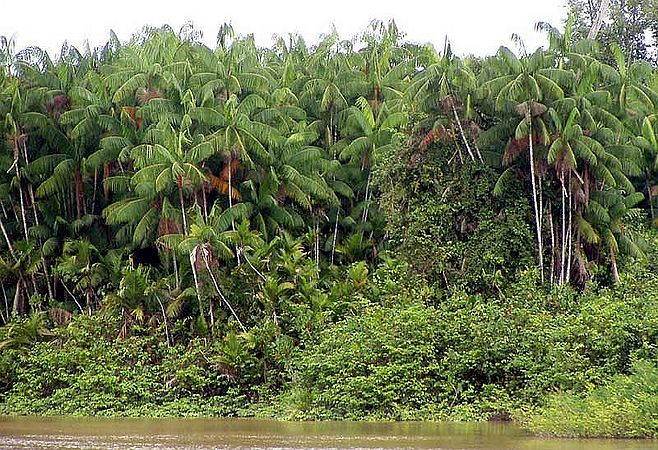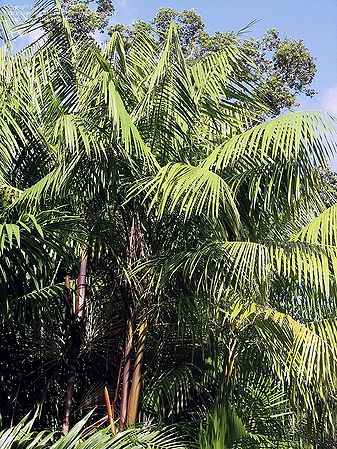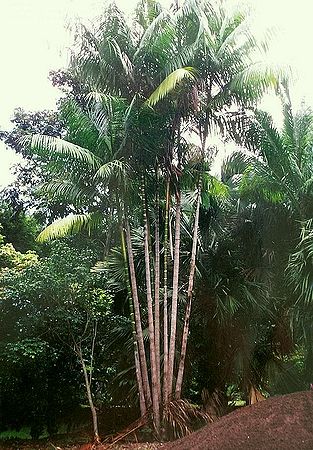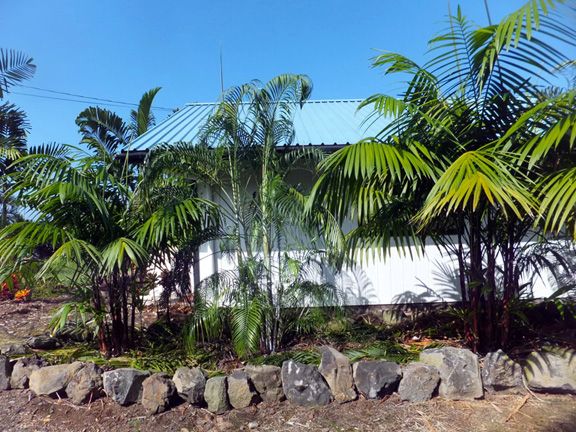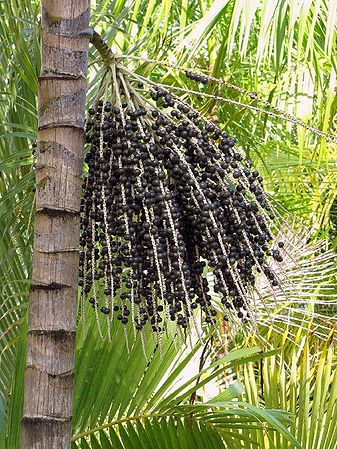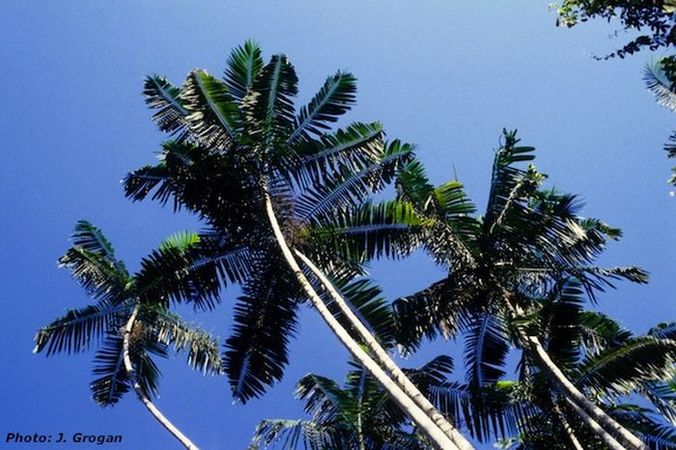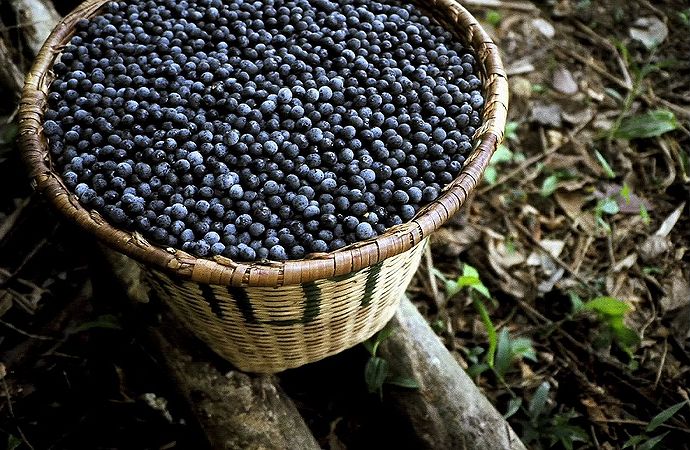Euterpe oleracea
| Euterpe (yoo-TEHR-peh) oleracea (oh-leh-rah-SEH-ah) | |||||||
|---|---|---|---|---|---|---|---|
 French Guiana. Photo-tipalm.fr | |||||||
| Scientific Classification | |||||||
| |||||||
| Synonyms | |||||||
|
| |||||||
| Native Continent | |||||||
|
| |||||||
| Morphology | |||||||
| |||||||
| Culture | |||||||
| |||||||
| Survivability index | |||||||
|
| |||||||
| Common names | |||||||
|
| |||||||
Contents
Habitat and distribution
Brazil North, Brazil Northeast, Colombia, Ecuador, French Guiana, Guyana, Suriname, Trinidad-Tobago, and Venezuela. Coastal regions in Brazil, Guyanas, Venezuela, Colombia, and Ecuador, in tidal fresh water swamps and in regularly inundated areas along rivers and streams. In Ecuador it is abundant in the river delta region. Panama (San Blas), Pacific coast of northern Ecuador (Esmeraldas, Pichincha) and Colombia (Cauca, Chocó, Córdoba, Nariño, Valle; and some areas of the Río Sinú and middle Magdalena valley in Antioquia, Córdoba, and Santander), Trinidad , Venezuela (Bolívar, Delta Amacuro, Sucre), the Guianas, and Brazil (Amapá, Maranho, Paná, Tocantins). It grows in large stands of high density in low-lying, tidal areas near the sea and in wet places near rivers, seldom occurring inland and then in wet places near streams or rivers. In the eastern Amazon basin it replaces Euterpe precatoria in these habitats. However, in the Pacific coastal region of Colombia and Ecuador, the two species are sympatric. Nevertheless, E. oleracea grows in inundated places, whereas E. precatoria grows on noninundated soils. Euterpe oleracea can be an aggressive colonizer of disturbed, swampy areas. Despite this, the habitat of the species is threatened by rice cultivation and shrimp farming in coastal Colombia, in swamps in French Guiana; Urdaneta, and in Venezuela. (Gloria Galeano and A. Henderson)/Palmweb.Description
Canopy palm. Stems clustering, to 20 m tall 10-20 cm in diameter. Leaves to 4 m long, 8 to 10 in the crown; crownshaft bluish green; petiole green, glabrous; pinnae to 100 on each side, regularly inserted, narrow, strongly pendulous, the central ones 60-110 cm long and 3-5 cm wide. Inflorescence erect, with axis 40-100 cm long; branches to 150, usually inserted on all sides of the rachis, to 70 cm long, 3-4 mm in diameter, densely covered with short, whitish brown hairs. Fruits black, globose, 1-2 cm in diameter. Endosperm ruminate. Seedling leaves deeply bifid. Stems caespitose (growing in tufts or clumps) with up to 25 stems per clump, or occasionally appearing solitary and then with shoots at the base, erect or leaning, 3-20 m tall, 7-18 cm diam., usually gray with lichens, with a cone of red roots at base, these to 1 cm in diam., and with pneumatophores. Leaves 8-14, arching; sheath 0.6-1.5 m long including a short ligule, dark brown, purple, green, dull red-green or yellow-green, with few, flat, scaltered, brownish scales especially on ligule; petiole 17-50 cm long, with few, flattened or raised scales or occasionally whitish, scurfy scales adaxially and on upper part of abaxial surface, mostly glabrous abaxially; rachis 1.5-3.7 m long, with similar scales like those of petiole; pinnae 40-80 per side, pendulous or less often horizontal (especially on younger plants), opposite to subopposite, long acuminate, with punctations abaxially, with prominent midvein and 2-3 lateral veins either side, the midvein with few ramenta abaxially; basal pinna 40-74 x 0.5- 1.5 cm; middle pinnae 0,6-1.1 m x 2-4.5 cm; apical pinna 24-50 x 0.6-1.8 cm. Inflorescences infrafoliar at anthesis, almost horizontal; peduncle 5-15 cm long, 2.7-4 cm in diam.; prophyll 43-66 cm long, 11-14 cm in diam.; peduncular bract 66-95 cm long, without an umbo; rachis 35-68 cm long, densely covered with whitish brown, branched hairs; rachillae (58-)80-162, 21-75 cm long, 3-4 mm in diam. at anthesis, thickening in fruit, absent from adaxial, proximal part of rachis, densely covered with very short, appressed, whitish brown hairs; flowers in triads proximally, paired or solitary staminate distally; triad bracteole rounded; first flower bracteole apiculate, second and third flower bracteoles unequal, rounded, the largest 1-1.5 mm long; staminate flowers 4-5 mm long; sepals triangular to ovate, 2-3.5 mm long, unequal, ciliate; petals ovate, 3-4 mm long, purple to purplered; stamens arranged on a short receptacle; filaments 1.5-4 mm long; anthers 2-2.5 mm long; pistillode 2-3 mm long, deeply trifid at apex; pistillate flowers 3 mm long; sepals broadly tririangular, 2 mm long, ciliate; petals broadly triangular, 2-3 mm 1ong. Fruits globose or depressed globose, 1-2 cm in diam., the stigmatic remains lateral; epicarp purple-black, black, or green, minutely tuberculate; seeds globose; endosperm deeply ruminate; eophyll bifid. (Gloria Galeano and A. Henderson)/Palmweb. Editing by edric.
Culture
It requires a hot, moist climate with part shade. It will take full sun as it matures and frost should be avoided.
Comments and Curiosities
| read more |
|---|
|
Uses: This species is important throughout its range because it produces both edible fruit and palm heart. In the Brazilian city of Belém, the fruits are an important part of the diet of a large proportion of the inhabitants (Wallace, 1853; Calzavara. 1972; Strudwick & Sobel, 1988). The fleshy mesocarp is mixed with water and made into a drink, and also recently into ice cream. Since the demise of Euterpe edulis as a source of palm heart, E. oleracea is currently the most important species. The canning and sale of palm heart was worth $120 million in 1988 (Strudwick & Sobel, 1988). On the Pacific coast of Colombia and Ecuador, too, there are canning factories for palm heart (Bernal, 1992). Because of its multiple stems, palm heart and fruits can be harvested without destroying the tree. This advantage, coupled with the fact that the palms grow in very high-density stands in the Amazon estuary, has recently attracted the attention of researchers interested in sustainable forest products. Anderson (1988) has discussed the use and management of forests dominated by E. oleracea near Belém. Throughout its range the palm is used for a host of minor items (see Borgtoft Pedersen & Balslev, 1990, for Ecuador). The stems are used for a variety of construction purposes. The young leaves are mashed and the sappy remains applied to stop bleeding or taken to stop hemorrhaging (J. Strudwick et al. 4681). Fruits and discarded seeds are fed to domestic animals. It is also commonly planted as an ornamental throughout the Amazon region in towns and near dwellings. (Gloria Galeano and A. Henderson)/Palmweb. After many native E. edulis palm groves disappeared, harvesters began using the acai palm as a more sustainable alternative since it produces many stems/trunks. Unlike it's cousin, when one of acai's stems is cut, more stems will grow back on the same root system and the cutting of some of the stems encourages fruiting on the remaining stems. Acai palm (E. oleracea) is now the world's main source of palm hearts. While Acai does offer a more sustainable alternative, it does not ensure that the correct exploitative harvesting methods will be used to guarantee the plant's survival. Huge stands of acai palm are often over-exploited and sometimes entire groves are clear-felled for palm heart exploitation. Currently, there is a shortage of raw materials in many locations in the Amazon River estuary due to over-harvesting and a lack of sustainable management of native stands; palm heart processing plants in the area generally operate only 2-3 days per week. Many botanists disagree that palm heart harvesting of any species is sustainable at all since ninety-five percent of the tree is wasted in the process. What may well guarantee it's survival is the new, rapidly growing, and profitable export market for the acai fruit, which might surpass the profits gleaned from harvesting the palm heart in the near future. TRIBAL AND HERBAL MEDICINE USES: In the Amazon, the acai palm heart is widely consumed as a vegetable, the fruit is prepared into a popular fruit drink and used as a natural ink or dye, and the wood is used in house construction (palm thatched roofs). Ethnobotanists have recorded no less than 22 different uses for all parts of the tree. In the Brazilian Amazon, the Indian tribes of the forest use all parts of the tree. They fell the tree and eat the palm heart, turn the fruit into a juice drink, and use the mature palm fronds for thatch for their house roofs. They then urinate on the rest of the felled tree to attract a species Rhynchophorus palm beetle to lay it's eggs inside the felled tree. Several weeks later, they return to harvest 3-4 pounds of beetle grub larvae which are an important source of protein (62%) and fat (4.5%) in their diet. The fruit juice is also very popular throughout the local communities and indigenous tribes of the Amazon; resulting in acai trees commonly planted in gardens, around villages, and in back yards. The fruit and palm hearts are also taken into river cities and towns where they are sold as cash crops by river- and forest-dwelling families. In Brazilian herbal medicine, the oil of the fruit is used to treat diarrhea; an infusion of the root is used for jaundice and to build the blood; an infusion of the grated fruit rind is used as a topical wash for skin ulcers; and, the fruit seeds are crushed and prepared in an infusion for fevers. In the Peruvian Amazon, an infusion of the toasted crushed seeds is used for fever, and a decoction of the root is used for malaria, diabetes, hepatitis and jaundice, hair loss, hemorrhages, liver and kidney diseases, menstrual pain, and muscle pain. In Colombia, where the trees grow along the Pacific coast line, it is called naidí and the fruit is turned into a common and popular drink. By far, the main use of acai by the local inhabitants of the Amazon is for the preparation of a thick, dark purple juice obtained by macerating the ripe fruits. In some areas, individual consumption of up to 2 liters daily has been recorded. It is often referred to as "poor-man's juice." It is so popular, there is usually a small special establishment called an acailandia in most Amazon river towns and villages that prepare the acai juice and sell it in small plastic bags. Although a basic part of the diet of the poor, acai liquid has become popular throughout all socioeconomic levels. It has a metallic nutty flavor with a creamy texture and oily appearance. To prepare the liquid the ripe fruits are soaked in water to soften the thin outer shell. The fruits are then squeezed and the large seeds strained out to produce a dense purple liquid with a distinctive flavor. In the Amazon, the liquid is often combined with a starchy root vegetable called manioc (which has been dried and ground into a flour) and is eaten as a purple porridge. It is mixed with sugar or sugar cane to sweeten and drunk as a beverage, as well as used to flavor ice cream, liquor and other desserts. Acai is a staple food for many economically disadvantaged inhabitants of the lower Amazon region area. The acai-manioc porridge is quite poor in nutrition but is very filling with a large amount of starch and sugar. In Belém, a major port and gateway into the Brazilian Amazon, an enormous acai fruit market called Feira do Acai houses 70 to 120 vendors selling over 200,000 kg of acai fruit daily during the dry season. The fruit juice is widely consumed as a staple, however, no medicinal properties have been associated with it. Prepared acai fruit drinks sell for about $2 per liter on the streets of Belém, making it highly affordable for everyone. PLANT CHEMICALS: The fruit liquid, called simply acai or vinho de acai (although it's not alcoholic or fermented) is not really that nutritious in comparison to many other fruit juices. The nutrient content analyzed is 1-4% protein, 7-11% fats, 25% sugar, 0.05% calcium, 0.033% phosphorous, and 0.0009% iron. It also has some sulphur, traces of vitamin B1 and some vitamin A and E. It also delivers 88 to 265 calories per 100 grams, depending on the preparation method. The dark purple color of the fruit is due to the polyphenolic compounds present. One of the main plant chemicals getting a lot of attention in acai, is a compound called anthocyanin. Anthocyanins are a group of flavonoids widely distributed in plants and lending a red to purple color to fruits like grapes, blackberries, and raspberries. As a well known antioxidant, anthocyanin-rich foods and fruits have been marketed as cancer preventative and anti-aging products. Anthocyanins have also been studied as novel sources of natural food colorings and dyes. The anthocyanin in acai however is highly unstable and degrades easily in the presence of heat, humidity, as well as in the presence of enzyme actions of other chemicals in the fruit. This makes acai fruit highly perishable; it readily changes in color, taste, and anthocyanin content with even short term (12 hours) refrigerated storage. In addition to the standard vitamins and minerals found in most fruits, the main plant chemicals in acai fruit include epicatechin, p-hydroxy-benzoic acid, gallic acid, (+)-catechin, protocatechuic acid, ellagic acid, p-coumaric acid, ferulic acid, vanillic acid, cyanidin, and pelaronidin 3-glucoside. |
- IMAGE GALLERY
External Links
- Glossary of Palm Terms
- MODERN BOTANICAL LATIN
- "Just To Be Clear"
- http://rainforest-database.com/plants/acai.htm
- http://scialert.net/fulltext/?doi=ijb.2008.303.308
- http://www.hear.org/starr/images/species/?q=euterpe+oleracea&o=plants
- http://www.fao.org/docrep/X0451E/X0451e08.htm
- http://www.photomazza.com/?Euterpe-oleracea
- https://www.youtube.com/watch?v=BOPPXf72ay8
References
Phonetic spelling of Latin names by edric.
Special thanks to Geoff Stein, (Palmbob) for his hundreds of photos.
Special thanks to Palmweb.org, palmweb.org, Dr. John Dransfield, Dr. Bill Baker & team, for their volumes of information and photos.
Glossary of Palm Terms; Based on the glossary in Dransfield, J., N.W. Uhl, C.B. Asmussen-Lange, W.J. Baker, M.M. Harley & C.E. Lewis. 2008. Genera Palmarum - Evolution and Classification of the Palms. Royal Botanic Gardens, Kew. All images copyright of the artists and photographers (see images for credits).
Gloria Galeano & A. Henderson. Flora Neotropica. New York Botanical Garden.
Many Special Thanks to Ed Vaile for his long hours of tireless editing and numerous contributions.
















